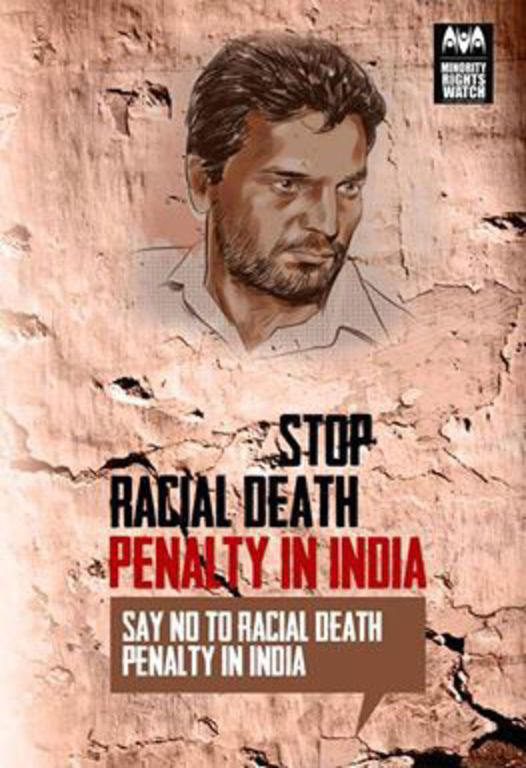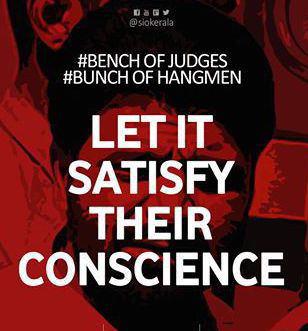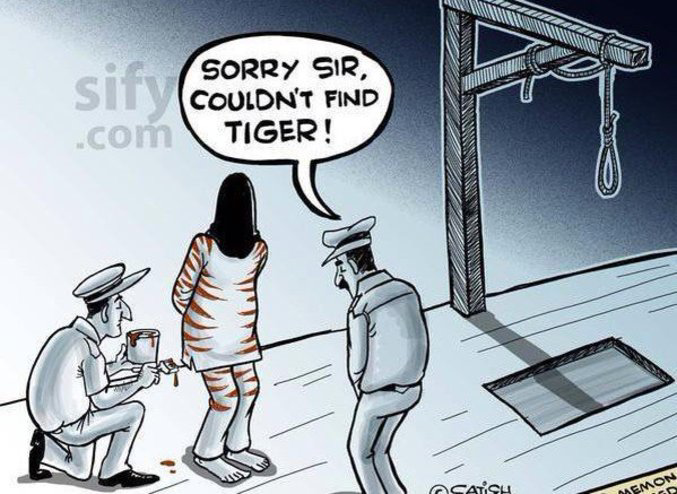The last week of July 2015 saw high drama on TV and social media surrounding the death penalty of the 1993 Bombay blasts convict Yakub Memon. On July 30, on his 53rd birthday, Memon was executed at around 7 am at the Nagpur Central Jail after his last mercy petition was rejected by the Supreme Court at 3 am the same morning. His body was later taken to his residence in Mumbai for last rites. The funeral was attended by over 10,000 people at the Bada Qabristan amidst tight security, supervised by intelligence agencies. The entire story from the Bombay bombings of 1993 to the rejection of mercy petition and the after-events of his execution were covered by the television channels like a reality show. Yakub was sentenced to death on charges of “criminal conspiracy to carry out terrorist act and disruptive activities, and murder and aiding, abetting and facilitating in a terrorist act.” The Supreme Court found him guilty of financing and providing logistical support to the deadly bombings that took over 257 lives and left many more injured.
Scores of people, who professed patriotism, peacefully gathered outside the Nagpur Jail and shouted slogans celebrating their motherland. Some of them broke into dance and took selfies, as a reminder of the moment when justice was delivered in the country. There was chest-thumping pride and bonhomie outside the jail. Even the press joined them and did a humane coverage talking about Yakub’s last breakfast and the compassionate way of execution, and secretly expressing their own feelings as well.
Former Supreme Court judge Justice Markandey Katju, known for his controversial remarks, said the evidence against Memon’s conviction was ‘very weak’ and called the execution a “gross travesty of justice”.
The thirteen coordinated bombings on March 12, 1993, were a direct fallout of the Bombay riots of December, 1992 and January ‘93, according to the Srikrishna Commission. These riots broke out after the Babri Masjid demolition of December 6, 1992. These three horrific events stained the national secular fabric of tolerance and harmony and affected the political discourse thereafter. It also gave the Kashmiri separatists and insurgents another excuse to continue with their political and militant activities. The prime accused in these bombings are Dawood Ibrahim and Ibrahim ‘Tiger’ Memon (Yakub’s brother), who masterminded the attacks and have fled from India.
Before the riots of 1992-93, Bombay was the busy and bindaas city of black & white taxis, high-rise buildings, Victorian monuments, Bollywood dreams and cricket on the maidans. It was India’s seaport to world trade and the free world. For a few years after the turmoil, the metropolis witnessed the rise of a streak of casteism and religious discrimination, its cosmopolitan spirit buried under the debris of bigotry. Later investigations have brought up the complex relationship between the police, political parties and the underworld.
In the past week, a variety of reactions flooded the media, especially the social media, ranging from solidarity to opposing death penalty on humanitarian grounds to proud celebration that justice has been finally delivered. They said a strong message had been sent out to all the traitors and their sympathisers. Some said Yakub was sent to the gallows because they couldn’t catch his brother ‘Tiger’, the real culprit. Evidence about his involvement is still being questioned and some say he “surrendered” in order to prove his innocence. The Governor of Tripura, Tathagata Roy, raised a controversy on Twitter by tweeting, “Intelligence should keep a tab on all (except relatives & close friends) who assembled before Yakub Memon’s corpse. Many are potential terrorists”. He later said, “There must be some potential threat element in these people. They ought to be kept under surveillance”.
Yakub Abdul Razak Memon, a chartered accountant, was the most educated member in the Memon family. Professionally and financially successful, Yakub was running an accounting firm, exporting meat and investing in buildings by 1992. In connection with the Bombay bombings, a 10,000-page primary chargesheet was filed against 189 accused, including the actor Sanjay Dutt. The case was handed over to the CBI in November, 1993. The trial was held at the Terrorist and Disruptive Activities (TADA) court, Bombay. According to the CBI, Yakub was arrested at the New Delhi Railway Station on August 5, 1994. Whereas, Yakub says he was arrested at the Delhi International Airport on July 24, 1994. The claim of the competent authority always outweighs that of the accused.
After the arrest of Yakub Memon and many others, written submissions of his case were made in the Mumbai TADA court by January, 1996. Some 1,000 witnesses and 50,000 pages of evidence were examined. The trial period spanned from 1995 to 2006. Yakub, along with 11 others, was sentenced to death on September 12, 2006 by the TADA court. Twenty others were given life sentences. Thereafter, the case was appealed at the Supreme Court which upheld the death penalty for Yakub in March, 2013. President Pranab Mukherjee rejected his mercy plea in May, 2014, and again in July, 2015, along with the Governor of Maharashtra. The Supreme Court later rejected all the review and curative petitions repeatedly, the last being on July 30, 2015 at 3 am. After this last rejection, Memon’s lawyers and activists cited a Supreme Court judgement in a different case to argue that he can’t be hanged for at least 14 days after his mercy plea is rejected. The Supreme Court rejected these arguments, stating that ample opportunity had been given to Yakub to file his petition after his mercy plea was first rejected.
Then, on the same morning, Dr. Anup Surendranath, Deputy Registrar (Research) at the Supreme Court, who was appointed more than a year ago on a contract basis, resigned just two hours after the court had upheld the death warrant. He resigned criticising the judgement clearing the death penalty for the 1993 Bombay blasts convict, saying that two decisions within a span of hours are instances of “judicial abdication” that should count among the “darkest hours” of the apex court. Prof. Surendranath is a faculty member at National Law University, Delhi, and Director of Death Penalty Research Project. He was also associated with the filing of the petition for the stay of Memon’s death warrant.
The entire operation of Yakub Memon’s capture was coordinated by an IPS officer, Bahukutumbi Raman. He has worked at the Intelligence Bureau, held a high rank in the Research & Analysis Wing (RAW) and was the Additional Secretary in the Cabinet Secretariat under the P V Narsimha Rao government. In a revealing article written in 2007, but published recently, Raman wrote about Yakub Memon’s arrest stating that he (Yakub Memon) had gone to Kathmandu secretly from Karachi to consult a relative and a lawyer on the advisability of some members of the Memon family, including himself, who felt uncomfortable with Pakistan’s Inter-Services Intelligence, returning to India and surrendering to the Mumbai Police. The relative and the lawyer advised him against surrender due to a fear that justice might not be done to them. They advised Yakub to go back to Karachi. Before he could board the flight to Karachi, he was picked up by the Nepal Police on suspicion, identified and rapidly moved to India.
Late Mr. Raman also said, “There is not an iota of doubt about the involvement of Yakub and other members of the family in the conspiracy and their cooperation with the ISI till July 1994.” Arguing for Yakub however, Mr. Raman, one of the most respected bureaucrats of the country, says, “If one takes into consideration his conduct and role after he was informally picked up in Kathmandu, there is a strong case for having second thoughts about the suitability of the death penalty in the subsequent stages of the case”.
The story of Yakub Memon’s life, his involvement in the bombings, the trap & capture and the later process was indeed a story full of twists and turns. His end was also shown on TV, and the ‘media circus’ resembled a tribal procession to the sacrificial altar. Only in this case, instead of the ‘Bollywoodesque’ “jhinga-la-la”, the urban tribals were shouting “democracy”.
With regards to the police and judicial functioning, some legal experts have reservations. In 2012, 14 retired judges wrote to the President pointing out that since 1996, the Supreme Court had erroneously given the death penalty to 15 people, of whom two were hanged. Former Supreme Court judge Justice Markandey Katju, known for his controversial remarks, said the evidence against Memon’s conviction was ‘very weak’ and called the execution a “gross travesty of justice”. He said that the evidence of ‘retracted confessions’ of the co-accused was unreliable. The judiciary relies completely on the evidence provided by police and there’s no provision to independently confirm them. Another former Supreme Court judge, Justice P B Sawant had once said, “For a criminal justice system to work properly, three different institutions – the investigating agencies, the prosecution and the courts – need to work in tandem”.
The treatment with death penalties in the past 20 years also raises questions. In the ten years spanning from 1983 to 1992, over 35 death penalties were executed. In the five-year period from 1993 to 1997, over 12 were hanged from the noose. The period between 1998 and 2011 – 13 years – had only one execution, in 2004. But from 2012 to 2015, three convicts were executed – Ajmal Kasab, Afzal Guru and now Yakub Memon. The assassins of Rajiv Gandhi and the former Punjab Chief Minister Beant Singh were pardoned and their death sentences were commuted to life imprisonment. The Gujarat rioters of 2002 Naroda Patiya case, like Maya Kodnani and Babu Bajrangi have been out on bail. Maya Kodnani, a gynecologist, held the office of MLA of the Naroda constituency, Gujarat, from 1998 to 2012. Some riot instigators have even got state funerals. Many of those co-accused with Yakub, including those who actually planted the bombs, have had their death penalties commuted. Yakub, therefore, is now the first convict to be hanged for the Bombay blasts.
Dr. Syed Abdul Rahman Gilani, a Kashmiri professor at Delhi University, was accused in connection with the attack on the Parliament House that occurred in December, 2001. He was falsely convicted and sentenced to death by the Special Court designated under the infamous Prevention of Terrorism Act (POTA). Later, the Delhi High Court acquitted him and observed that the police had forged documents and fabricated evidence. Another six men were sentenced to death in connection with the Akshardham Temple attacks of September, 2002 by a POTA court. Their death sentences were upheld by the Gujarat High Court, but were quashed by the Supreme Court in May 2014, due to lack of evidence.
The Supreme Court later rejected all the review and curative petitions repeatedly, the last being on July 30, 2015 at 3 am. After this last rejection, Memon’s lawyers and activists cited a Supreme Court judgement in a different case to argue that he can’t be hanged for at least 14 days after his mercy plea is rejected.
On the other hand, the Nirbhaya gang-rape case of December, 2012 is still pending in courts, despite a nationwide public outrage. It has been pending for one year in the Supreme Court and is almost at a standstill. And then we remember the recent acquittal of Jayalalithaa and how Ramalinga Raju and Jagan Mohan Reddy were released on bail.
A recent study by the National Law University, Delhi, shows that a mind-boggling 94 per cent of people on death row are from minorities and weaker sections of the society. Many organizations, therefore, on the grounds of judicial errors and humanitarianism, have been opposing death penalties, including Amnesty International India. While most developed countries have abolished death penalties, the US executed over 35 convicts in 2014 alone and China 607.
There are certain things about which we can be sure. No doubt, desecrating historic religious monuments is evil. No doubt, avenging one massacre with another is also evil. Two wrongs do not make a right. It will only lead to a vendetta. The police-judicial system is certainly not effective enough in bringing all the perpetrators of crimes against the nation to justice. Law would be equal for all only if all the perpetrators of mass murder are given the same punishment or dealt with clemency. The police, international diplomacy and intelligence agencies seem to be quite frustrated about catching the real culprits, or negotiating their repatriation with other countries. India had to put a lot of diplomatic and political effort to bring back Abu Salem from Portugal.
Of course, the success of the public institutions rests on the integrity and unity of the society. As we celebrate our 69th Independence Day anniversary, we need to assess how far we have come from the social evils that made us slaves of the British. As our first law minister, Dr. B R Ambedkar said, “So long as you do not achieve social liberty, whatever freedom is provided by the law is of no avail to you”. The three pillars of a democracy are Legislature, Executive and Judiciary. In the recent days, we have seen how the monsoon session of the Parliament has been going. We know that some state agencies are large violators of law, despite the Prime Minister’s Swachh Bharat Abhiyan. Media is said to be our fourth pillar while Indian journalists are more likely to face hostilities than their Pakistani counterparts. We are witnessing the recent news of Usman Khan’s arrival at Udhampur, Jammu & Kashmir. Our retribution to Afzal Guru or Ajmal Kasab certainly did not deter him. It also raises questions about the leniency of the security forces after so many incidences of intrusion.
The health of a human body depends upon its ability of its immune system to counter the pathogens. As the immune system weakens, the body becomes increasingly vulnerable to diseases. It doesn’t matter how strong its bones & muscles are, or how beautiful the individual is. Similarly, the health of any regime depends upon the society and its ability to raise some people, who will revive it from time to time and neutralize those who seek to weaken it internally and externally. Our society is one that asks nudity from its government, while ignoring the rampant human trafficking and exploitation. Yakub Memon, as of now, has become the poster boy against death penalty. To prevent more Yakubs and Kasabs from cropping up, not only do we need robust institutions and system, but also changes in society that will treat its vulnerabilities and prevent the yield of anti-social elements. For indeed, the condition of a people will not change, until they change what is in themselves.







[…] of secularist, Brahminic, and nationalistic conscience, like Yakub Memon, Abdul Nazar Maadani, Sirajunnisa, Ishrat Jahan etc. and many fictional characters who were […]